Character reference letter template for coworker
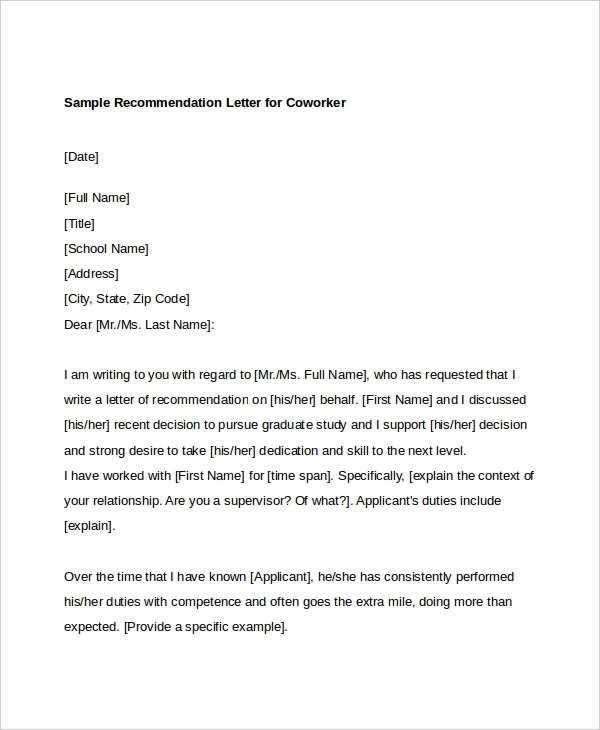
Begin your letter with a brief introduction of who you are and your relationship with the coworker. State how long you have worked together and the capacity in which you know them. This context sets the tone and gives the reader insight into the depth of your perspective.
Example: “I have had the pleasure of working closely with John for the past three years in our marketing department. Throughout this time, I’ve observed his dedication, strong work ethic, and ability to collaborate effectively within our team.”
Focus on specific traits or skills that make your coworker stand out. Highlight their work ethic, reliability, or teamwork. Be as concrete as possible by mentioning instances where these qualities were clearly demonstrated.
Example: “John consistently exceeded expectations in project management, often going beyond his assigned tasks to ensure the success of our campaigns. His ability to solve problems quickly and efficiently made him an invaluable asset to our team.”
End the letter with a clear endorsement. Reaffirm your belief in their capabilities and your confidence in their future success. If appropriate, offer to provide further information if needed.
Example: “Without hesitation, I highly recommend John for any future opportunities. His dedication and talent will undoubtedly bring value to any organization.”
Character Reference Letter Template for Coworker
To craft a convincing character reference letter for a coworker, focus on specific instances of their contributions and personal qualities. Begin by addressing the recipient and stating your relationship to the coworker. Mention the length of time you’ve worked together and the capacity in which you have interacted. This helps set the context for your observations.
Structure and Key Points
Start with a strong opening sentence that highlights your support for the coworker. Avoid vague statements; instead, detail why you believe they are a good fit for the position or purpose of the letter. Highlight particular traits such as reliability, dedication, or teamwork, providing concrete examples where these qualities were evident. Be honest and direct in your assessment.
Closing Remarks
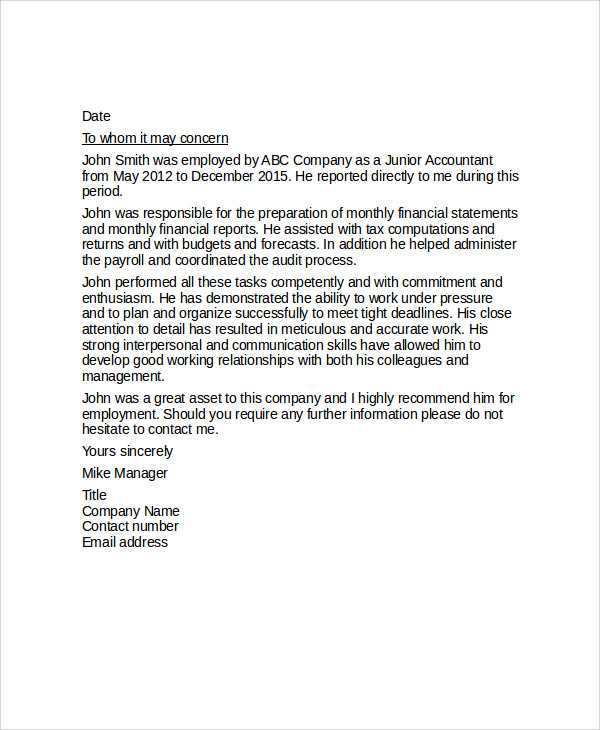
Finish by reiterating your confidence in the coworker’s character and abilities. Offer to provide additional details if needed, and end with a formal sign-off, including your contact information. This ensures the recipient knows they can reach out for further clarification.
How to Structure the Opening Paragraph
The opening paragraph sets the tone for your character reference letter. Focus on introducing yourself and explaining your relationship with the coworker. Start by stating how long you’ve known them and in what capacity. Be clear about your role and their role, ensuring it’s relevant to the context of the reference.
Here’s how you can structure it:
- State your name and job title: Begin with a brief introduction of who you are, including your position and your working relationship with the coworker.
- Define the context: Mention the time span you’ve worked together and the nature of the tasks or projects you’ve shared.
- Establish trust and authority: Express that you can provide a reliable evaluation based on firsthand experience, highlighting the direct interaction you’ve had.
This approach makes it clear to the reader that you are a credible source for the recommendation and prepares the foundation for the specific attributes you’ll discuss in the following sections.
Key Traits to Highlight When Writing About a Coworker
Focus on specific qualities that make the coworker stand out. Highlight their work ethic, emphasizing their consistency in meeting deadlines and willingness to take on new tasks. Describe their problem-solving skills, providing examples of how they’ve handled challenges in the workplace. It’s valuable to mention their ability to collaborate with others, showing how they contribute to team success and create a positive working environment.
Showcase their communication skills, noting how effectively they express ideas and listen to others. Mention their reliability, especially when entrusted with important projects or responsibilities. If applicable, emphasize any leadership qualities, including the way they motivate peers and guide teams toward achieving goals. Mention their adaptability, especially how they manage changes in the workplace or new project demands with ease.
In addition, discuss their attention to detail and organizational skills, ensuring their work is accurate and well-planned. If relevant, include any technical expertise or knowledge that makes them an asset to the team. Tailor your comments to reflect the coworker’s unique contributions and the value they bring to the work environment.
How to Mention Specific Examples of Skills and Achievements
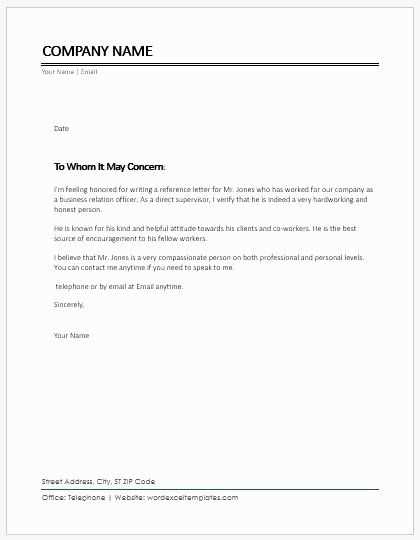
To make a strong impression in a character reference letter, illustrate the coworker’s abilities with clear, real-life examples. Focus on specific moments when they demonstrated key skills that align with the job or role they are pursuing. For instance, rather than stating they are “a good leader,” mention a particular project where they led a team through a challenging deadline, emphasizing their decision-making and communication skills.
Highlight Problem-Solving Abilities
Include examples of situations where your coworker solved complex problems. Describe the issue, the approach they took, and the successful outcome. For instance, if they identified inefficiencies in a workflow and proposed a solution that saved time or resources, be specific about the impact. Mention numbers or percentages if possible to show the tangible results of their efforts.
Focus on Collaboration and Teamwork
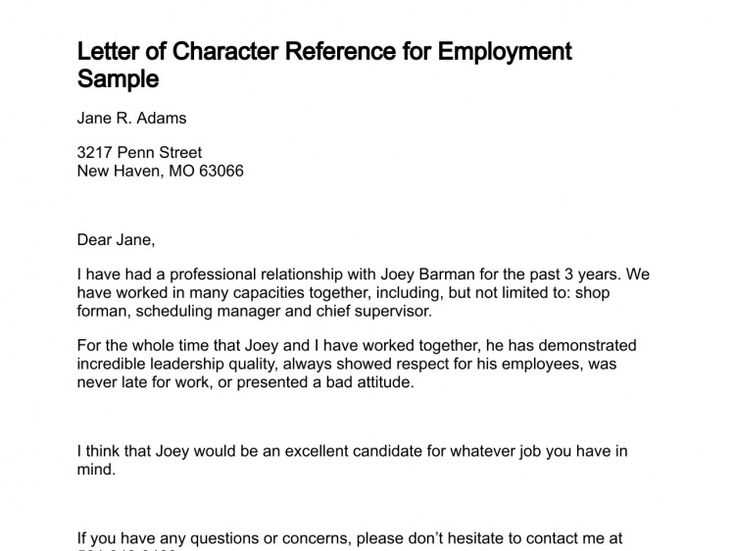
When referencing teamwork, focus on occasions when your coworker worked effectively with others. Share an example where their ability to collaborate stood out, such as resolving conflicts or bringing together diverse perspectives to meet a common goal. Be clear about the role they played and how it contributed to the team’s success.
By incorporating these concrete examples, you highlight not only their skills but also the value they add in a professional environment. The more specific the example, the more convincing the letter will be.
Discussing Personal Qualities That Complement Professional Attributes
Highlighting a coworker’s personal qualities is crucial when writing a character reference letter. These traits often play a pivotal role in how they work within a team or handle challenges. A coworker with a natural sense of empathy brings a strong human element to the workplace, making communication smoother and fostering better relationships with colleagues. This quality can greatly enhance collaboration and ensure that teamwork is not just about getting the job done, but about respecting each person’s needs and perspectives.
Another important trait is reliability. When an individual consistently meets deadlines and follows through on commitments, it provides the foundation for trust and dependability within the workplace. A reliable coworker helps maintain project momentum, ensuring that the team can rely on each other without constant follow-ups.
Positive attitude is another asset that shouldn’t be overlooked. A coworker who approaches tasks with an optimistic and solution-focused mindset can elevate the mood of the entire team, making it easier to tackle even the most difficult challenges. This attitude contributes not only to morale but also encourages others to adopt the same approach to problem-solving.
Additionally, adaptability is crucial for any team dynamic. Being able to adjust to changes in processes or unexpected situations without getting overwhelmed shows strength and resilience. A coworker who is adaptable is often able to offer creative solutions when the team faces roadblocks, demonstrating both resourcefulness and flexibility.
Framing the Closing Paragraph with Clear Endorsement
Conclude with a direct, confident recommendation that reinforces the coworker’s strengths and qualities. State clearly why you believe they will excel in the role or task they are pursuing. Instead of vague praise, focus on specific attributes or skills that make them a standout candidate, based on your experience working together.
Be Specific in Your Support
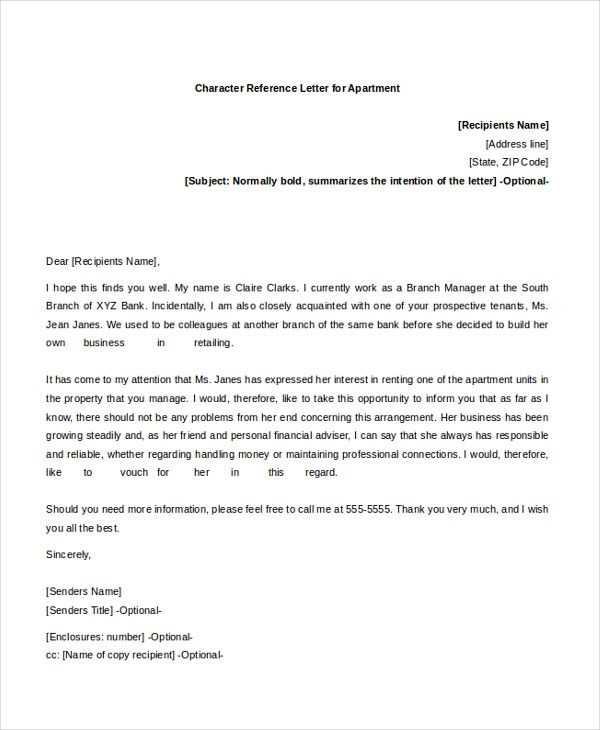
For example, instead of simply saying “I highly recommend them,” specify how their contributions positively impacted projects or team dynamics. Mention any key successes or moments where their work truly shined. Highlighting achievements provides weight to your endorsement and builds credibility.
Keep the Tone Positive and Assertive
Avoid hedging or sounding uncertain. Phrases like “I believe” or “I think” can weaken the strength of your endorsement. Instead, focus on confidently asserting that the coworker’s skills will be an asset wherever they go, ensuring that your final message is both clear and convincing.
Ensuring Proper Formatting and Professional Tone
Maintain a clear and readable layout by using standard business letter formatting. Align the text to the left and use single spacing, leaving space between paragraphs. This structure improves readability and helps convey professionalism. Keep the margins at 1 inch on all sides for a clean look.
Choose a formal font, such as Arial or Times New Roman, in size 11 or 12. Avoid using any decorative fonts that could detract from the professional tone of the letter. Stick to black text on a white background for maximum clarity.
When addressing the recipient, use their full name and title if known. If unsure, use a polite generic salutation like “Dear Hiring Manager.” For the closing, “Sincerely” or “Best regards” are appropriate, followed by your full name and title (if applicable).
| Section | Details |
|---|---|
| Header | Your name, position, and contact information at the top. |
| Greeting | Use a formal greeting, such as “Dear [Recipient’s Name].” |
| Body | Introduce the coworker, mention specific skills, and provide examples of their work. |
| Conclusion | Offer to provide further information and express confidence in the coworker’s abilities. |
| Closing | End with “Sincerely” or another polite phrase, followed by your name and contact information. |
In the letter’s body, focus on specific qualities and accomplishments of the coworker. Use positive language while remaining objective. Keep sentences short and direct, avoiding unnecessary embellishments. This approach maintains a formal and confident tone.
Proofread the letter to ensure there are no spelling or grammatical errors. A polished document reflects your attention to detail and strengthens the impression of both you and the coworker.